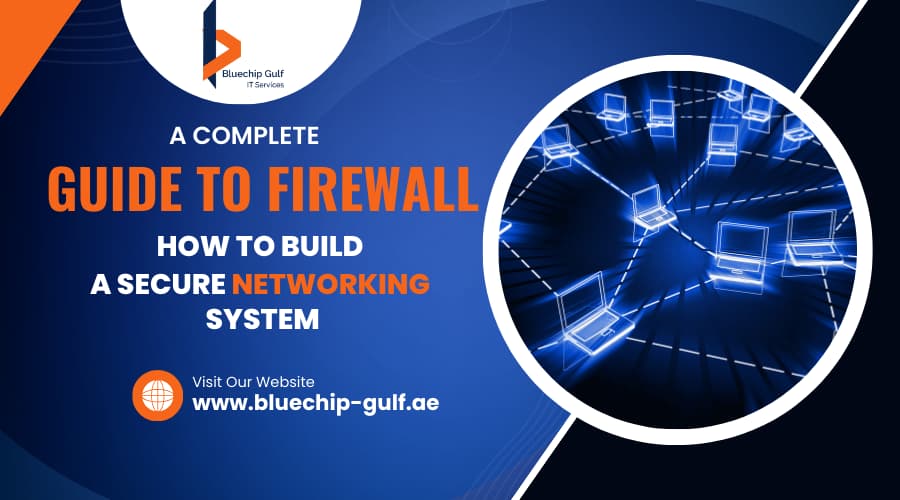
In today’s interconnected world, the value of a secure Networking System cannot be overstated. In a digital landscape where businesses and individuals rely on the fluid exchange of data, safeguarding your network is paramount. One of the foundational elements of network security is the firewall. In this comprehensive guide, we’ll embark on a journey to understand the essence of firewalls, the varying types at your disposal, and the steps to erect a resilient Networking System fortified by these sentinels.
Understanding Firewalls
A firewall is a quintessential component of network security, whether manifested as hardware or software. Its principal role is to serve as a guardian between your internal network and the vast universe of external networks, primarily the internet. Firewalls scrutinize, filter, and wield control over inbound and outbound network traffic, governed by a predetermined set of security rules. They are meticulously designed to fend off unauthorized access and thwart malevolent intrusions, thereby preserving data integrity and safeguarding the sanctity of your systems.
Types of Firewalls
1. Packet Filtering Firewalls
Packet filtering firewalls, the foundational layer of firewall architecture, exercise scrutiny at the granular level of data packets. They adjudicate the fate of these packets, allowing or disallowing their passage based on pre-established rules. The criteria for decision-making typically encompass source and destination IP addresses, ports, and protocols. While proficient in their role, packet filtering firewalls may exhibit constraints when confronted with complex, multifaceted attacks.
2. Stateful Inspection Firewalls
Stateful inspection firewalls, often celebrated as dynamic packet filters, elevate the game by preserving cognizance of active connections. They are informed gatekeepers who make decisions grounded in contextual awareness of Networking System This heightened awareness empowers them to dispense superior security, recognizing the state of connections and distinguishing them as part of established sessions.
3. Proxy Firewalls
Proxy firewalls assume the guise of intermediaries, stationed between your internal network and external domains. They function as interpreters, fielding requests from clients and transmitting them on behalf of these clients to the destined servers. This intermediary layer offers an extra coating of security by shrouding the internal network architecture. However, this proxy mechanism can introduce some latency due to the additional step in the data transmission process.
4. Application Layer Gateways (ALGs)
ALGs specialize in the application layer of the OSI model, understanding the nuances of specific applications and their associated protocols. They have the acumen to render informed decisions based on the attributes of application traffic. For instance, they can grasp the intricacies of FTP, DNS, or HTTP requests and responses, bestowing a finer degree of control.
5. Next-Generation Firewalls (NGFWs)
NGFWs represent the vanguard of firewall technology. They amalgamate conventional firewall attributes with additional security capabilities, encompassing intrusion prevention systems (IPS), antivirus protection, and content filtering. The comprehensive armory offered by NGFWs fortifies networks against modern threats.
Building a Secure Networking System with a Firewall
Building a secure Networking System under the vigilant eye of a firewall is an intricate process demanding meticulous planning, adept technology selection, and unwavering commitment to perpetual management. Let’s scrutinize each step meticulously –
1. Defining Your Security Policy
The bedrock of your journey commences with the formulation of a discernible security policy for your organization. This policy should delineate –
- Objectives – Chart the course of your security objectives. Clarify what facets of your network necessitate protection and from which quarters threats may arise.
- Acceptable Behavior – Etch in stone the contours of acceptable conduct on your Network . Set forth guidelines for employees, contractors, and any entities interfacing with your Networking System
- Data Classification – Envisage a stratification of data based on its sensitivity. Realize that not all data is equally pivotal, and stratify it in alignment with the urgency of protection.
- Access Controls – Define the precincts of access rights. Specify who merits access to what and craft user roles and access controls that facilitate the implementation of these specifications.
2. Selecting the Apt Firewall Type
The judicious selection of the right type of firewall is the keystone of erecting a secure Networking System Here’s an illumination of prevalent firewall types –
- Stateful Inspection Firewall – These evolutionary entities of packet filtering firewalls retain awareness of active connections, engendering decisions grounded in connection context. They furnish enhanced security in comparison to traditional packet filters.
- Next-Generation Firewall (NGFW) – The heralds of modern firewall technology, NGFWs amalgamate traditional features with auxiliary security functionalities, constituting an impervious bulwark against contemporary threats.
3. Crafting Firewall Rules
Configuration of your firewall rules constitutes the marrow of network security. These rules dictate the permissibility of network traffic. Here’s how to chart your course –
- Reference Your Security Policy – Ascertain that your rules harmonize with the objectives and acceptable conduct inscribed in your security policy.
- Specificity Rules Supreme – The more specific your rules, the more potent they become. Instead of restraining an entire protocol, pinpoint the source and destination ports, IP addresses, and protocols to allow or deny.
- Leverage Advanced Features – Many firewalls are equipped with advanced features like application layer filtering and deep packet inspection. Employ these attributes to reinforce your network’s security.
4. Sustaining Vigilance Through Updates and Maintenance
Sustaining the vigor of your firewall software and rules is indispensable to tackling vulnerabilities and burgeoning threats. Here’s your itinerary –
- Software Updates – Keep your firewall software and firmware up-to-date to preclude exploitation of known vulnerabilities.
- Rule Review – Periodically scrutinize your firewall rules. Discard archaic or superfluous rules and append fresh ones in consonance with your network’s evolution.
- Security Audits and Penetration Testing – Engage in security audits and penetration testing to unmask frailties in your firewall’s configuration. This regimen will ensure that your firewall is adept at shielding your Networking System
5. Monitoring and Analysis
The establishment of a robust monitoring and analysis system is a linchpin of network maintenance. Execute the following –
- Real-time Visibility – Deploy monitoring tools that confer real-time insight into your network traffic. This capability empowers you to spot irregular patterns and detect nascent threats in the bud.
- Alert Mechanisms – Engrain alert mechanisms for suspicious activities. Your firewall should issue alerts when predefined conditions are met, summoning your IT brigade to fend off potential security breaches.
- Log Scrutiny – Periodically scrutinize logs generated by your firewall. Log analysis can reveal trends, identify vulnerabilities, and uplift your overall network security apparatus.
6. Nurturing a Security-Conscious Workforce
In the realm of network security, the human constituent is a potent force. The enlightenment of your users regarding safe online practices and their role in network security is paramount. Key components of user training encompass –
- Phishing Awareness – Impart knowledge to your users to discern phishing attempts. These are common gateways for threats to infiltrate your Networking System . Educate your workforce on how to detect suspicious emails and links.
- Social Engineering Education – Train your users in recognizing and mitigating social engineering tactics that malefactors employ to manipulate them into revealing sensitive information.
- Emphasis on Password Security – Champion the cause of strong password practices, such as the use of complex passwords and their periodic alteration.
- Incident Reporting Protocol – Ensure that your users are conversant with the mechanism for reporting security incidents or suspicious activities to your IT crew in a prompt manner.
Embracing Additional Security Measures
While firewalls wield considerable authority in the domain of network security, they are but one aspect of a comprehensive security strategy. It is judicious to contemplate the incorporation of additional security measures such as intrusion detection systems (IDS), intrusion prevention systems (IPS), antivirus software, and routine security evaluations. These complementary layers of defense erect a formidable bulwark against a threat landscape in ceaseless flux.
Also Read: Replacing vs. Upgrading a Previous Networking System

